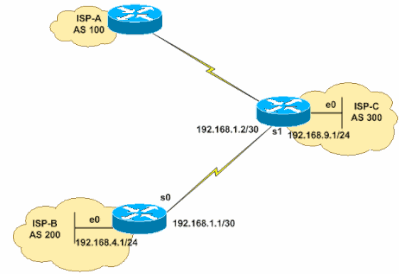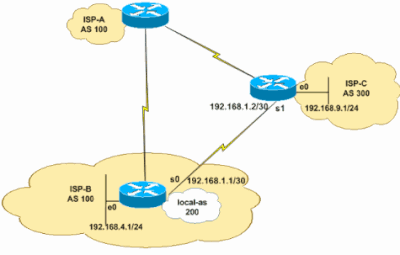Introduction
This document describes the Border Gateway Protocol (BGP) local-AS feature, which was initially available in Cisco IOS®Software Release 12.0(5)S.
Prerequisites
Requirements
This document recommends knowledge of the BGP routing protocol and its operations. For more information, refer to the Examine Border Gateway Protocol Case Studies.
Components Used
The information in this document was created with this software version, but is not restricted to specific software and hardware versions:
The information in this document was created from the devices in a specific lab environment. All of the devices used in this document started with a cleared (default) configuration. If your network is live, ensure that you understand the potential impact of any command.
Conventions
For more information on document conventions, refer to the Cisco Technical Tips Conventions.
Background Information
The local-AS feature allows a router to appear to be a member of a second autonomous system (AS), in addition to its original AS. This feature can only be used for true eBGP peers. You cannot use this feature for two peers that are members of different confederation sub-ASs.
The local-AS feature is a useful tool when one ISP acquires another, as it allows routers in the acquired ISP to seamlessly join the acquiring ISP's AS. This is particularly beneficial when the acquired ISP's customers prefer to maintain their existing peering arrangements and configurations. With the local-AS feature, routers in the acquired ISP can appear as members of the acquiring ISP's AS, while still retaining their original AS number in the eyes of their customers. This ensures a smooth transition and minimizes disruptions for the acquired ISP's customers.
For example, refer to the network diagrams, where in Figure 1, ISP-A has not yet purchased ISP-B and inFigure 2, ISP-A has purchased ISP-B, and ISP-B uses the local-AS feature. If ISP-A purchases ISP-B, but ISP-B customers do not want to modify any configuration, the local-AS feature allows routers in ISP-B to become members of ISP-A (100) AS. At the same time, these routers appear to their customers to retain their ISP-B (200) AS number.
In Figure 2, ISP-B now belongs to AS 100, and ISP-C (customer) to AS 300. When peering with ISP-C, ISP-B uses AS 200 as its AS number with the use of the neighbor <ISP-C> local-as 200 command. In the BGP updates sent from ISP-B to ISP-C, the AS_SEQUENCE in the AS_PATH attribute contains "200 100". The "200" is prepended by ISP-B due to the local-as 200 command configured for ISP-C.
Normally a combined ISP-A/B renumbers the routers in ISP-B to be part of AS 100. What if ISP-C is unable to change its eBGP configurations with ISP-B? Prior to the local-AS feature, the combined ISP-A/B has to maintain two AS numbers. The local-as command allows ISP-A/B to physically be one AS while it appears to be two ASs to ISP-C.
Command Syntax
This list shows the syntax of the commands that the configurations in this document use:
Local-AS cannot be customized for individual peers in a peer group.
Local-AS cannot have the local BGP protocol AS number or the AS number of the remote peer.
The local-as command is valid only if the peer is a true eBGP peer. It does not work for two peers in different sub-ASs in a confederation.
Configure
This section presents you with the information to configure the features this document describes.
Network Diagrams
This document uses these network setups.
Figure 1

Figure 2

Configurations
This document uses these configurations:
| ISP-B (AS 100, local-as 200) |
hostname ISP-B
!
interface serial 0
ip address 192.168.1.1 255.255.255.252
!
interface ethernet 0
ip address 192.168.4.1 255.255.255.0
!
router bgp 100
!--- Note the AS number 100. This is the AS number of ISP-A, which is now
!--- used by all routers in ISP-B after its acquisition by ISP-A.
neighbor 192.168.1.2 remote-as 300
!--- Defines the e-BGP connection to ISP-C.
neighbor 192.168.1.2 local-as 200
!--- This command makes the remote router in ISP-C to see this
!--- router as belonging to AS 200 instead of AS 100.
!--- This also make this router to prepend AS 200 in
!--- all updates to ISP-C.
network 192.168.4.0
!
!
|
| ISP-C (AS 300) |
hostname ISP-C
!
interface serial 1
ip address 192.168.1.2 255.255.255.252
!
interface ethernet 0
ip address 192.168.9.1 255.255.255.0
!
router bgp 300
neighbor 192.168.1.1 remote-as 200
!--- Defines the e-BGP connection to ISP-B.
!--- Note AS is 200 and not AS 100.
network 192.168.9.0
!
!
|
Verify
This section provides information you can use to confirm your configuration properly works.
View the BGP routing table to see how the local-as command changed the AS_PATH. What you observe is that ISP-B prepends AS 200 to updates that are sent to and received from ISP-C. In addition, note that ISP-B is in AS number 100.
ISP-B#show ip bgp summary
BGP router identifier 192.168.4.1, local AS number 100
BGP table version is 3, main routing table version 3
2 network entries and 2 paths using 266 bytes of memory
2 BGP path attribute entries using 104 bytes of memory
1 BGP AS-PATH entries using 24 bytes of memory
0 BGP route-map cache entries using 0 bytes of memory
0 BGP filter-list cache entries using 0 bytes of memory
BGP activity 2/6 prefixes, 2/0 paths, scan interval 15 secs
Neighbor V AS MsgRcvd MsgSent TblVer InQ OutQ Up/Down State/PfxRcd
192.168.1.2 4 300 29 29 3 0 0 00:25:19 1
In this output, note that ISP-C sees ISP-B as part of AS 200.
ISP-C#show ip bgp summary
BGP table version is 3, main routing table version 3
2 network entries (2/6 paths) using 480 bytes of memory
2 BGP path attribute entries using 192 bytes of memory
0 BGP route-map cache entries using 0 bytes of memory
0 BGP filter-list cache entries using 0 bytes of memory
Neighbor V AS MsgRcvd MsgSent TblVer InQ OutQ Up/Down State/PfxRcd
192.168.1.1 4 200 34 34 3 0 0 00:30:19 1
Notice in this output that ISP-B prepends "200" to the routes learned from ISP-C.
ISP-B#show ip bgp
BGP table version is 3, local router ID is 192.168.4.1
Status codes: s suppressed, d damped, h history, * valid, > best, i - internal
Origin codes: i - IGP, e - EGP, ? - incomplete
Network Next Hop Metric LocPrf Weight Path
*> 192.168.4.0 0.0.0.0 0 32768 i
*> 192.168.9.0 192.168.1.2 0 0 200 300 i
Notice that ISP-C sees routes from ISP-B with an AS_PATH of "200 100".
ISP-C#show ip bgp
BGP table version is 3, local router ID is 192.168.1.2
Status codes: s suppressed, d damped, h history, * valid, > best, i - internal
Origin codes: i - IGP, e - EGP, ? - incomplete
Network Next Hop Metric LocPrf Weight Path
*> 192.168.4.0 192.168.1.1 0 0 200 100 i
*> 192.168.9.0 0.0.0.0 0 32768 i
These commands show the configured local-as values in their output:
ISP-B#show ip bgp neighbors 192.168.1.2
BGP neighbor is 192.168.1.2, remote AS 300, local AS 200, external link
BGP version 4, remote router ID 192.168.9.1
BGP state = Established, up for 00:22:42
Last read 00:00:42, hold time is 180, keepalive interval is 60 seconds
Neighbor capabilities:
Route refresh: advertised and received(old & new)
Address family IPv4 Unicast: advertised and received
Message statistics:
InQ depth is 0
OutQ depth is 0
Sent Rcvd
Opens: 1 1
Notifications: 0 0
Updates: 2 1
Keepalives: 25 25
Route Refresh: 0 1
Total: 28 28
Default minimum time between advertisement runs is 30 seconds
Troubleshoot
The debug ip bgp updates command displays the received prefixes with its attributes from the neighbor. This output shows that the prefix 192.168.4.0/24 is received with AS PATH 200, 100.
ISP-C#
*May 10 12:45:14.947: BGP(0): 192.168.1.1 computing updates, afi 0, neighbor version 0, table version 5, starting at 0.0.0.0
*May 10 12:45:14.947: BGP(0): 192.168.1.1 send UPDATE (format) 192.168.9.0/24, next 192.168.1.2, metric 0, path
*May 10 12:45:14.947: BGP(0): 192.168.1.1 1 updates enqueued (average=52, maximum=52)
*May 10 12:45:14.947: BGP(0): 192.168.1.1 update run completed, afi 0, ran for 0ms, neighbor version 0, start version 5, throttled to 5
*May 10 12:45:14.947: BGP: 192.168.1.1 initial update completed
*May 10 12:45:15.259: BGP(0): 192.168.1.1 rcvd UPDATE w/ attr: nexthop 192.168.1.1, origin i, metric 0, path 200 100
*May 10 12:45:15.259: BGP(0): 192.168.1.1 rcvd 192.168.4.0/24
*May 10 12:45:15.279: BGP(0): Revise route installing 192.168.4.0/24 -> 192.168.1.1 to main IP table
ISP-C#
Related Information


 Feedback
Feedback